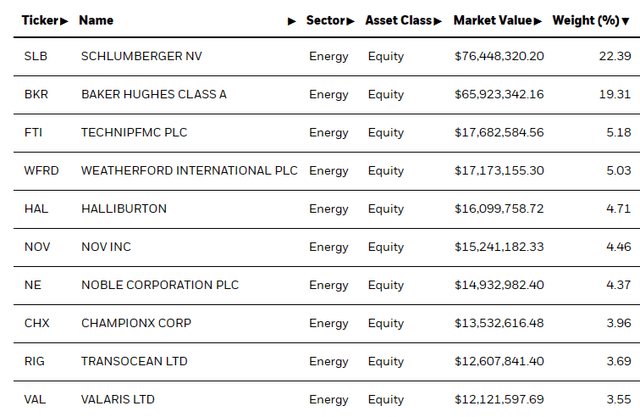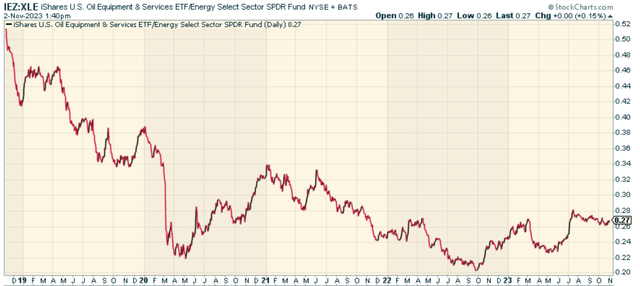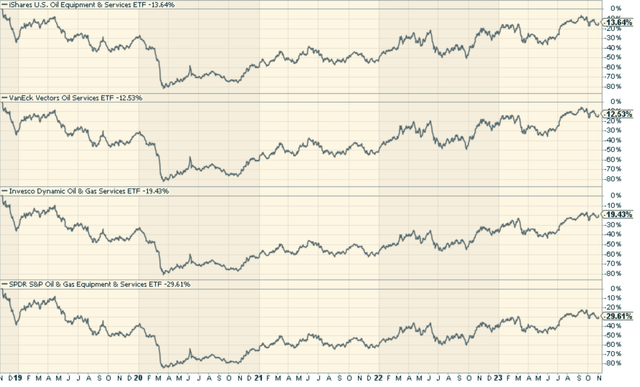CreativeNature_nl
There are a lot of ways to position for higher Oil prices outside of buying futures themselves. On the equity side, I’m a fan of the iShares U.S. Oil Equipment & Services ETF (NYSEARCA:IEZ). It’s a good fund and tracks well with Oil strength when it’s there, with targeted exposure to the U.S. companies operating in the niche sector of oil equipment and services.
Overview of IEZ
Launched on May 1, 2006, IEZ is designed to track the performance of the Dow Jones U.S. Select Oil Equipment & Services Index. This index is composed of U.S. equities in the oil equipment and services sector, providing investors with a targeted access to this specific sector of the domestic market. As of November 1, 2023, the fund has $336,930,818 in net assets.
IEZ’s underlying companies are primarily involved in providing the necessary equipment and services for oil exploration and production. Although these companies don’t directly profit based on the price of oil, their stock prices are heavily influenced by it, which makes IEZ’s performance intrinsically linked to oil price fluctuations.
Top Holdings and Sector Allocation
Diving deeper into IEZ’s portfolio, it becomes evident that the fund is heavily skewed towards a few significant players in the oil equipment and services sector. Schlumberger NV (SLB) and Baker Hughes (BKR) together make up approximately 41% of the fund, providing a substantial exposure to these market leaders.
In cumulative terms, the top 10 holdings constitute approximately 75.5% of the fund’s total assets. The primary sector, oil and gas equipment and services, accounts for 76% of the fund’s market value.
High concentration risk yes, but still good exposure nonetheless.
Performance and Risk Analysis
If we look at IEZ relative to the Energy Select Sector SPDR ETF (XLE), we can see the fund has underperformed, but recent relative strength has been improving, which makes sense given underinvestment in the space for a long time.
Peer Comparison
Notable competitors to IEZ include the VanEck Oil Services ETF (OIH), Invesco Dynamic Oil & Gas Services ETF (PXJ), and the SPDR S&P Oil & Gas Equipment & Services ETF (XES). The fund has clearly lagged PXJ and XES, and that largely has to do with the concentration risk in IEZ.
While all these ETFs offer exposure to the oil equipment and services sector, each offers a unique portfolio composition and investment strategy. For instance, PXJ and XES adopt an equal-weighted strategy, leading to a more balanced allocation among their holdings. In contrast, IEZ and OIH employ a market-capitalization-weighted approach, resulting in a skewed allocation towards larger companies in the sector.
Market Dynamics and Future Outlook
Understanding the market dynamics that influence the performance of IEZ’s holdings is crucial for prospective investors. The global energy sector, and by extension, the oil equipment and services sector, is influenced by a multitude of factors ranging from geopolitical tensions and OPEC decisions to global demand-supply dynamics and currency fluctuations.
While ongoing geopolitical tensions and supply-side constraints have been bullish for oil prices, the transition towards cleaner energy and the potential downside risks to global oil demand pose significant challenges. However, the strategic importance of oil and the ongoing investments in oil exploration and production activities suggest that the demand for oil equipment and services is likely to remain robust in the near to medium term.
Conclusion
Investing in IEZ offers a unique opportunity to gain targeted exposure to U.S. companies operating in the oil equipment and services sector. While the fund has demonstrated some short-term momentum weakness, its long-term performance underscores the high-risk nature of the sector. The fund’s heavy concentration in a few top holdings and its relatively high expense ratio are other factors that investors should consider. I think it’s a good fund, just make sure you’re bullish on Schlumberger and Baker Hughes.






